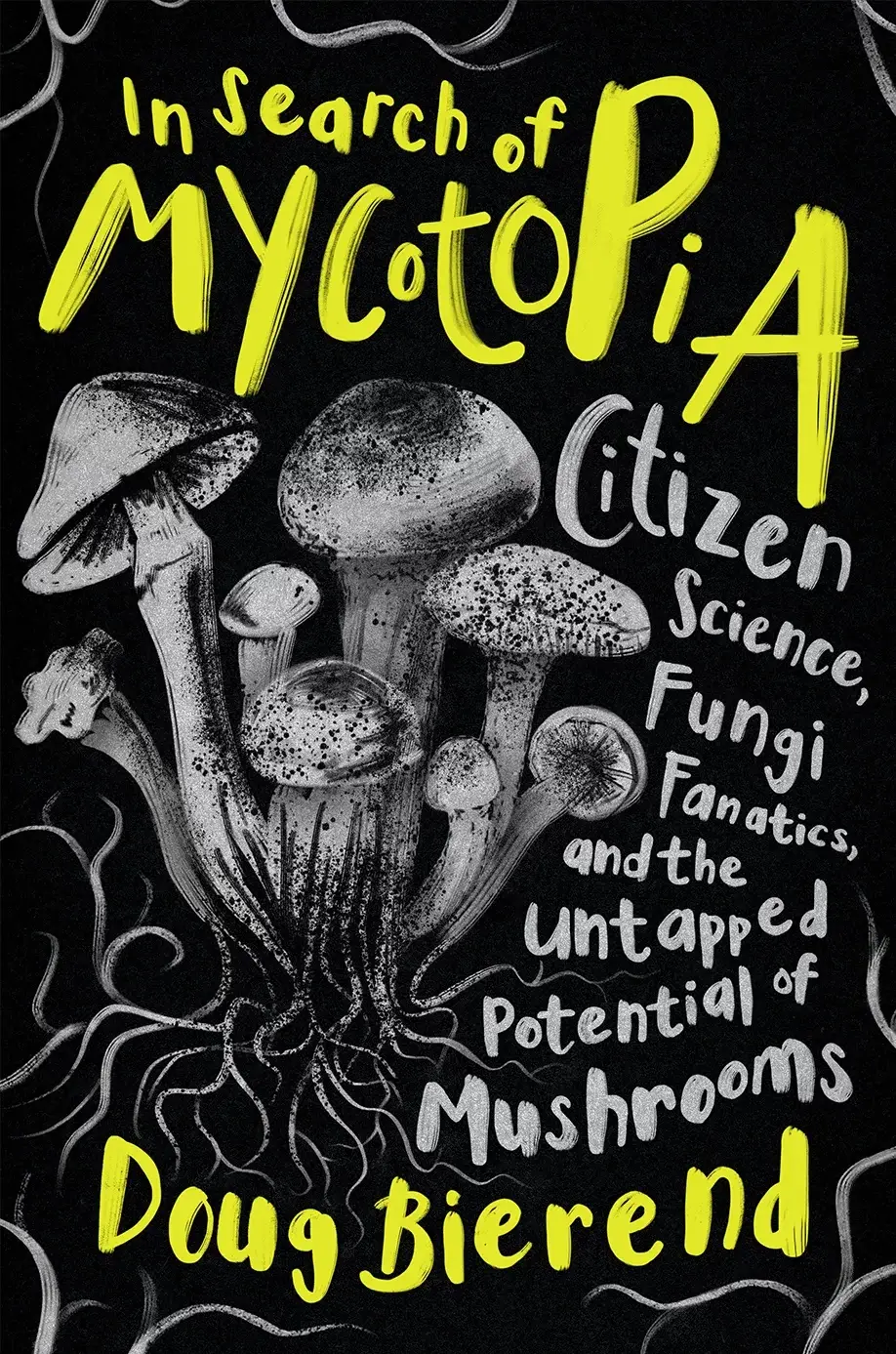Most mycophiles are aware that there a growing number of younger folks entering mycology who have been inspired, especially by the writings and TED Talks of world-renowned myco-evangelist, Paul Stamets. The charismatic Pied Piper of practical mycology has had a similar effect on many of us ‘old timers’ as well as on the one to three generations of young idealists born after ours. Few of us are unmoved by the extraordinary accomplishments of the founder of FungiPerfecti. The closing slide of his presentations reveal an image of branching mycelium reaching out from the earth’s organisms into the cosmos presumably connecting every planet, star and galaxy within a complex, integrated and unified web of communication. Seeing it, elicits rounds of heartfelt applause. Unsurprisingly, nature journalist Doug Bierend was also captivated by Stamets’ Ted talks.
Bierend’s initial contact with adherents of mycology committed to effecting solutions to our ongoing and worsening environmental problems, though, was through meeting entrepreneur mushroom cultivator, Olga Tsogas. She is founder of Smugtown Mushrooms in Rochester, N.Y. and collaborator of Mycelium Underground. The latter is nation-wide community of mostly women, one of a growing number of informal social communities with unconventional names like Decolonize Fungi, Female and Fungi, Fungi for the People, and the Radical Mycology Convergence, among other anti-establishment monikers. Olga and friends introduced the author to woodland macro fungi, their myriad morphologies and modes of survival. That initial experience led Bierend and his wife to make contact with similarly infatuated enthusiasts. He set out to learn why they are engaged in promoting widespread knowledge about the hidden world of fungi, and encouraging each other to learn cultivation techniques, and conducting experiments designed to effect solutions to environmental problems. His emergent passion for mycology and curiosity about what drives the friendly, diverse and idiosyncratic folks involved in these endeavors, was his reason for writing his first book. It is about principally young amateur mycologists, their motivations and beliefs for propagating widespread commitment to ‘saving the earth’ with fungi.
Bierend interviewed many individuals with names familiar to members of established mushroom organizations associated with NAMA, such as Alan Rockefeller, Christian Schwarz, William Padia-Brown, Tradd Cotter, Bill Sheehan, Peter McCoy and others. Some of these talented individuals are involved with the Fungal Diversity Survey (FunDis) and have been actively promoting citizen science to expedite and facilitate the documentation and collection of native fungal species. This activity involves learning how to properly observe, photograph and record fungal finds, engage in genetic sequencing, and preserving these materials along with related specimen in a university, botanical or home fungarium. The program evolved in concert with professionals and amateurs and has helped foster closer amateur ties with university mycology professionals. Mycology is unusual in being a field of science that is open to and that can benefit from the collaborative efforts of amateur amateurs working in concert with professionals. Most of the above-mentioned are also involved in propagating the message that nearly all life forms of life are dependent on the ignored fungi kingdom. Having evolved over millions of years via mutualisms with other organisms, fungi are seen as undervalued decomposers, and distributors of nutrients.
While Bierend spends a fair amount of time elucidating the ambitions that drive the above-mentioned devotees of amateur mycology, his research has exposed an uncomfortable fact that established mycological organizations have come to recognize. Most contemporary myco-advocates have limited direct connections with the major mycological associations that first sprung to life in the 1960’ and 1970’s. Like the some of the founders of the early mycological clubs, many of today’s myco trailblazers have been fundamentally inspired to learn more about fungal lifestyles after experiencing untethered connections to life with mind-expanding psychedelic mushrooms. Some have been exposed to the myriad hobbies and activities involving fungi via the annual Telluride Fungi Festival, known for its speakers, forays, carnival-like parades, art, dye workshops, culinary workshops and its magic mushrooms. Others have caught the myco-bug from mushroom cultivators, and from myco-social activists like Peter McCoy. He has communicated with potential adherents via his books, talks and presence on social media and has organized many Radical Convergence festivals to draw in folks searching for meaningful ways to pursue a satisfying life course and the means to survive outside conventional expectations. The focus of these celebratory events is on educating participants about the potential of fungi to provide the world with tools to feed, repair and heal the earth. Organizers draw on talent within the community to introduce novices to mycology. Invited ‘expert’ instructors are not always well-versed in the subject. What matters to the founders is that they have spawned many communities of zealots who have been encouraged to pass on information about how fungi cooperate with other organisms. Their purpose is to promote mushroom cultivation on a local level, instruct farmers and gardeners of the benefits of soil fungi to soil biodiversity over fertilizers, inspire entrepreneurs to experiment with ways to control and eliminate waste, to remediate soils, to purify contaminated water, air, and oceans using fungi, to manufacture fungal medicines. Certainly, these are all worthy goals and activities.
These and other mushroom educational events have been formed by amateur mycologists, ecologists, cultivators, and educators devoted to promoting appreciation of the neglected world of fungi. Bierend points out that many of the folks drawn to pursuing an independent career involving fungi are or feel marginalized for being ‘different’. Many are creating businesses based on cultivation of popular edibles, nutraceuticals and a plethora of fungal preparations used medicinally. The mycorrhizal lifestyle of fungi in particular has provided a generation of solution-oriented idealists and entrepreneurs with a powerful metaphor for fostering spiritual, social, economic, and environmental change. They have chosen an independent anti-capitalist path to survival that respects fungi and their own struggles to gain the respect of a society despite not having university doctoral degrees in mycology. They are generally for the democratization of mycology and medicine and applying current knowledge of the kingdom’s representatives to educate and address their concerns about waste, hunger, air and water pollution, climate change incurred by oil spills and practices of big agricultural farming that destroy the diversity of formerly bioactive soils.
So why don’t these younger generations care to join any of the established mycology organizations? Some at least have issues with our ways of conducting forays. Most of the original members of mycology clubs still around are now aging gray-haired retirees – ‘stuck’ in our conventional and outdated preference for searching for unusual specimens, identifying them, and eating edibles. Some in the new generation are not particularly fascinated by learning scientific nomenclature or how to identify fungi that are not edible or has no known medicinal use. They object to our collecting thousands of fungi for table identification, and then throwing out duplicates and the entire lot after they’ve been duly recorded. Critics have a legitimate point here. More and more we are subjecting unusual finds to DNA analysis, and hopefully more clubs will consider tossing left-over fungi collections back into the forest or into compost heaps rather than into giant plastic garbage bags destined for the dump. Certainly, we do not need everyone to collect every fungus seen during a multi-day foray, given that so many of the same species are collected day after day by tens of us.
Some consider members of established mycological organizations ‘old’. Presumably gray-haired middle-age and older folks lack understanding or empathy with their optimism about succeeding in their worthy multi-faceted endeavors. Personally, I feel that most folks interested in mycology – even older ones like myself – are also ‘different’, come from many varied backgrounds, and are unconventional. Most of us are rather liberal, support social diversity and care about humanities’ often deleterious effects on our planet and its inhabitants. We are as curious, thoughtful and entranced about our connections to fungi as those in the youth myco-movement. Our love and appreciation of the fungal kingdom is what draws us all together.
I have even introduced a couple of local young enthusiasts to mycology who have gone on to establish mushroom cultivation businesses to serve the communities in the Pioneer Valley of Western MA. Thanks to them, our supermarkets now offer a wide variety of fresh locally cultivated edible fungi for sale. It is difficult work requiring having a reliably dedicated staff who will show up to maintain and grow a fledgling mushroom business. I have also taught mycology classes to wonderful well-meaning students in their twenties and thirties who have jumped on the medicinal mushroom bandwagon. I am personally not an advocate of promoting fungal medicinals for preventing or curing diseases until evidence-based testing can demonstrate they are effective beyond their unquestionable nutritional value. However, I continue to urge people of any age to explore all legitimate scientific avenues to eventually prove me misguided and ‘old fashioned’. In areas of the world lacking any reliable medical resources, edible mushrooms grown on waste materials, and fungal tinctures and pills may at least provide a healthy food source and give hope to the sick.
Over the past few years, several excellent tomes have been published on the broad subject of mycology, and about the quirky people who are passionately engaged and even employed in a growing list of mushroom related activities designed to ‘save the world’. Eugenia Bone, Langdon Cook and Michael Pollen, for example, have artfully explored and elucidated the underground connections of fungi and other organisms below and above the soil. They have also investigated the ideas, ideals, and dreams of its most ardent proponents from scientific, historical, social and philosophical perspectives. Free-lance nature journalist Doug Bierend brings us up to date on the social makeup, activities and philosophies that drive an expanding cadre of mainly younger devotees to act as ambassadors of mycology, and its democratization. For those who may be interested in gaining insight into amateur mycology in all of its current manifestations – from cultivation to fermentation – I highly recommend this well-written book. It is thoroughly researched and presents the reader with a sympathetic, yet reflective view of contemporary popular mycology.


NAMA Store >